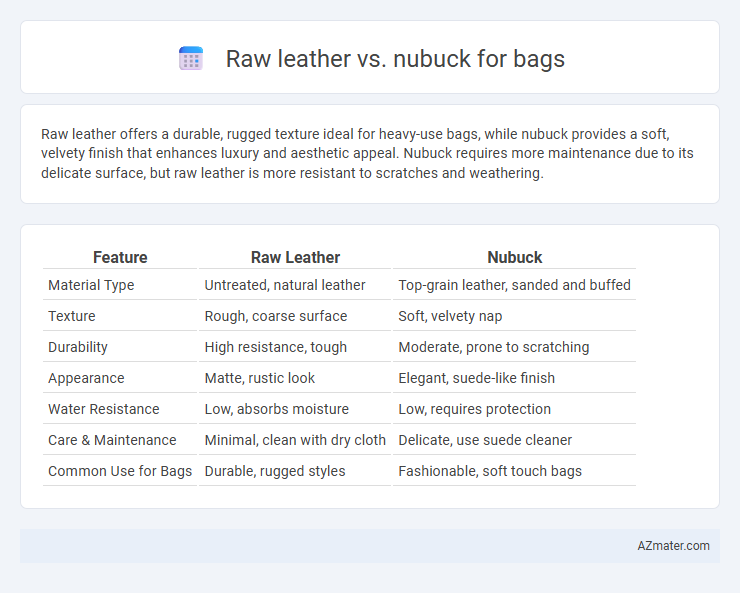Raw leather offers a durable, rugged texture ideal for heavy-use bags, while nubuck provides a soft, velvety finish that enhances luxury and aesthetic appeal. Nubuck requires more maintenance due to its delicate surface, but raw leather is more resistant to scratches and weathering.
Table of Comparison
| Feature | Raw Leather | Nubuck |
|---|---|---|
| Material Type | Untreated, natural leather | Top-grain leather, sanded and buffed |
| Texture | Rough, coarse surface | Soft, velvety nap |
| Durability | High resistance, tough | Moderate, prone to scratching |
| Appearance | Matte, rustic look | Elegant, suede-like finish |
| Water Resistance | Low, absorbs moisture | Low, requires protection |
| Care & Maintenance | Minimal, clean with dry cloth | Delicate, use suede cleaner |
| Common Use for Bags | Durable, rugged styles | Fashionable, soft touch bags |
Introduction: Raw Leather vs Nubuck for Bags
Raw leather offers a rugged, natural texture that develops unique patinas over time, enhancing the character of bags with durability and a rich, organic appearance. Nubuck, crafted by sanding the outer layer of full-grain leather, provides a soft, velvety surface that is both visually appealing and supple, ideal for luxurious bag finishes. Choosing between raw leather and nubuck for bags depends on the desired balance of toughness, tactile feel, and aesthetic sophistication.
What is Raw Leather?
Raw leather refers to untreated, unprocessed animal hide that retains its natural texture and fiber structure, offering a rugged and authentic appearance. In contrast to Nubuck, which is sanded and buffed to create a soft, velvety surface, raw leather is more susceptible to moisture and stains but provides a distinct, durable finish ideal for rustic or vintage-style bags. Its natural toughness and aging properties make raw leather a preferred choice for users seeking organic aesthetics combined with long-term durability.
Understanding Nubuck: Key Features
Nubuck is a type of leather made from the outer side of a hide, sanded or buffed to create a soft, velvety surface with a slight nap, distinguishing it from raw leather's rougher texture. Unlike raw leather, which is untreated and more susceptible to stains and wear, nubuck undergoes a light sanding process that enhances its durability and gives it a refined, matte finish ideal for premium bags. Its porous surface requires special care to maintain its appearance, making nubuck both visually appealing and practical for high-quality leather accessories.
Appearance: Raw Leather vs Nubuck
Raw leather showcases a rugged, natural texture with visible grain and imperfections, offering a rustic and authentic appearance for bags. Nubuck leather boasts a soft, velvety surface achieved by sanding the outer layer, creating a smooth, matte finish with a subtle sheen. While raw leather emphasizes durability and a vintage look, nubuck provides a refined, plush aesthetic favored in premium handbag designs.
Durability and Longevity Comparison
Raw leather, characterized by its untreated and natural surface, offers exceptional durability due to its thick hide and resistance to wear and tear. Nubuck, made by sanding the outer layer of raw leather to create a soft, velvety texture, sacrifices some durability for aesthetic appeal, making it more susceptible to stains and abrasions over time. When comparing longevity, raw leather bags generally outperform nubuck, maintaining structural integrity and appearance longer with minimal maintenance.
Texture and Feel: Which is Better?
Raw leather offers a rugged, naturally textured surface with a firm and durable feel, ideal for those seeking a sturdy and rustic bag. Nubuck, created by buffing the outer layer of raw leather, provides a velvety, soft texture with a smooth finish that enhances tactile appeal and luxury. Choosing between raw leather and nubuck depends on the desired balance between robustness and plush comfort for your bag's texture and feel.
Maintenance and Care Requirements
Raw leather bags demand regular conditioning and protection from moisture to prevent cracking and stains, while Nubuck bags require gentle brushing with a suede brush and careful avoidance of water to maintain their velvety texture. Storing raw leather in a cool, dry place helps preserve its natural oils, whereas Nubuck benefits from specialized protective sprays to repel dirt and water. Both materials need prompt attention to spills and dirt, but Nubuck is generally more delicate and labor-intensive in terms of maintenance.
Cost Differences: Investment Value
Raw leather bags typically cost less upfront due to simpler processing, offering a budget-friendly investment for basic durability. Nubuck bags demand a higher price reflecting the meticulous sanding and buffing process that enhances softness and aesthetics, increasing their long-term value. The investment value of nubuck lies in its premium look and feel, making it a preferred choice for higher-end, stylish bags.
Best Uses: Ideal Bag Types for Each
Raw leather offers durability and a rugged aesthetic, making it ideal for sturdy backpacks and messenger bags designed for outdoor or heavy-duty use. Nubuck's soft, velvety texture suits elegant handbags and laptop bags where style and a refined appearance are prioritized. Raw leather excels in casual, everyday bags requiring toughness, while nubuck enhances premium, fashion-forward accessories needing a polished finish.
Final Verdict: Choosing the Right Material
Raw leather offers a rugged, natural look with high durability, making it ideal for heavy-use bags that develop unique patinas over time. Nubuck, sanded on the grain side for a soft, velvety texture, provides a more refined and elegant appearance but requires careful maintenance to prevent stains and water damage. Choosing the right material depends on whether durability and a rustic aesthetic or a polished, sophisticated look with gentle care suits your lifestyle and bag usage.

Infographic: Raw leather vs Nubuck for Bag
 azmater.com
azmater.com